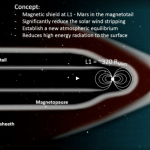
WHY THIS MATTERS IN BRIEF
- If Mars is ever going to become humanity’s second home it’s going to have to be terraformed, the first step in achieving that is giving it an atmosphere
Mars might be better as the Red planet today but there’s plenty of evidence to suggest that it used to be an active planet once covered in oceans and a thick atmosphere, and if we’re ever going to colonise it properly then we need to think terraforming and shields. Magnetic shields to be precise – that protect not just a small section of the red planet, but all of it.
Think big, or go home seems to be the theme behind NASA’s new strategy to help us terraform Mars and if you’re going to put some crazy ideas out there then heck, why not go big!?
Speaking at the Planetary Science Vision 2050 Workshop conference in Washington, James Green, the director of NASA’s Planetary Science Division told the audience that scientists that the agency has come up with a plan to help shield Mars from the Sun’s rays by using an artificial magnetic field that protects the planet. Without a protective magnetic field, anyone living on the Red Planet would have to protect themselves from the harmful radiation from the Sun that we, on Earth, are shielded from.
Green described the idea as involving a “magnetic shield” launched in a stable orbit between Mars and the Sun, and it would be made of a large electric circuit powerful enough to generate an artificial magnetic field. Think Magneto from the X-Men stuck in space protecting Mars from dangerous rays and you get the picture. Awesome – I’m sending that script to Hollywood right now.
Anyhow, one film in the bag later, Green said that the shield would allow Mars to slowly restore its atmosphere over the course of just three years. Then, once an atmosphere had built up, the greenhouse effect would take over and heat up the planet, potentially making it warm enough for liquid water to exist on its surface.
“Perhaps one-seventh of the ancient ocean could return to Mars,” he said, “the solar system is ours, let’s take it. That, of course, includes Mars and for humans to be able to explore Mars, together, with us doing science, we need a better environment.”
Mars did once have its own magnetic field that protected its atmosphere. Roughly 4.2 billion years ago, the planet’s magnetic field disappeared causing Mars’ atmosphere to slowly be lost to space and Green’s plan isn’t the first time the idea has been proposed. Second time lucky?
In a paper published in 2008, researchers at the National Institute for Fusion Science in Japan described an idea to create a magnetic field on Mars using superconducting magnets circling the whole planet.
“Here we show that a series of planet-encircling superconducting rings can provide an artificial geomagnetic field equivalent to 10 per cent of the present-day field necessary to prevent adverse effects,” the authors wrote, and while no further work was done on the project the fact that NASA’s picked it up might help to breathe new life into it.
Over the past year we’ve seen both SpaceX and Boeing make announcements about colonising the red planet, and NASA has even gone so far as designing a habitat for Mars’ first colonists and one day who knows, maybe those colonists will be able to walk about outside, chill out down the beach, obviously avoiding the alien sea monsters, and breathe the fresh air. Sign me up.


















